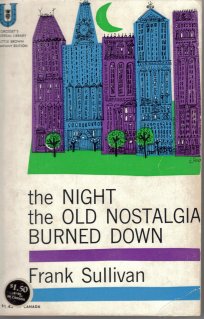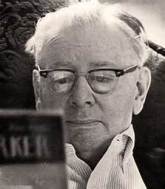The 20th Century American humorist Frank Sullivan is beginning to enjoy a much-deserved revival in the 21st Century! “The Sage of Saratoga,” as he is lovingly called in his birthplace, Saratoga Springs, was in his heyday a renowned humorist and regular contributor to The New Yorker magazine, a member of the Algonquin Round Table, and a published author whose works delighted millions.
Thomas Dimopoulos reports in Saratoga Today‘s “Sage of Saratoga Honored with National Literary Landmark” that Frank Sullivan’s home on 135 Lincoln Avenue in Saratoga Springs is to be dedicated as a “Literary Landmark” by United for Libraries, a division of the American Library Association. This gives Frank’s home the same honor as places associated with other great American authors as diverse as Dorothy Parker, Mark Twain, W. E. B. DuBois, Laura Ingalls Wilder and Frederick Douglass, to name just a few.
In addition, Saratoga Springs Public Library will feature “Frank Sullivan at His Best,” a selection of Frank Sullivan’s writings that are the library’s 2017 choice for the SaratogaReads! a community-wide reading and discussion initiative. Hats off to Saratoga Springs Public Library Director Issac Pulver!
On a personal note, Frank Sullivan came into my family’s life in 1946, when my parents, George and Jane King, moved to Saratoga Springs. They rented the first floor of 121 Lincoln Avenue, just down the street from Frank’s home, where he lived with his sister Kate. My father had accepted the job as Manager of MacFinn’s Drugstore on Broadway and Frank immediately reached out to the young couple, starting a friendship that lasted until Frank’s death 30 years later. Even after we moved from Saratoga, my mother corresponded with Frank and stayed in touch with him until he died in 1976. For our family, then, simultaneously thinking of Frank Sullivan as both a dear friend and a great author was very easy.
However, I have to recognize, however grudgingly, that forty years have passed since Frank’s death, and many more since his heyday, and people’s memories are short. So, in this time when we need gentle humor served with real intellect, it’s wonderful that the humorist whose New York Times obituary described him as “a gentle wit” is being brought back for a whole new generation to enjoy.
For those of you not familiar with Frank Sullivan, here’s a thumbnail biography of him. Frank was born in 1892 in Saratoga Springs on 177 Lincoln Avenue, next door to the Saratoga Race Track and not far from his second and last home on 135 Lincoln Avenue. He was educated in Saratoga—meaning then that he not only attended schools there, but also worked at the track, where he received a liberal expansion of his scholarly education. As Alden Whitman wrote in his New York Times obituary of Frank, “Frank Sullivan, Humorist, Dies at 83; A Gentle Wit and Spoofer of Cliches”
As a boy of 10 he worked as a pump boy in the betting ring at the race track. On one occasion he served a glass of water to Lillian Russell, the actress, who tipped him 50 cents and said to him:
“Thank you, little boy. Tastes better out of a tin cup, too.”
“It was a swell job,” Mr. Sullivan said of his pump‐boy job, “easy hours, plenty to see, little to do, 10 to 15 bucks a day in tips and no income tax.”
While in Saratoga Springs High School, Frank was also a part-time reporter for The Saratogian. He went on to Cornell University, graduated in 1914, and then returned to the Spa City to write full time for The Saratogian.
So far, much of that description typifies the careers of many hundreds of newspaper reporters of that era, but Frank’s rise to renown began right after World War I. Drafted into the US Army in 1917, he served as a Lieutenant. Post-war, he moved to New York City and briefly worked as a reporter for the Sun and then the New York Herald, before joining The World in 1922. Very significantly, in 1925 he also began a long association with The New Yorker magazine, newly created by Harold Ross. That literary relationship lasted until a little before Frank’s death in 1976.
Frank’s fame began in the Roaring Twenties and it is this part of his life that I know will provide some keen biographer with the core of an excellent book. Simultaneously writing for The World and The New Yorker, while contributing to the Saturday Evening Post and other magazines, Frank Sullivan also became an “unofficial” member of the Algonquin Round Table. A daily luncheon gathering at Manhattan’s Algonquin Hotel, the Round Table included newspaper reporters, columnists, and humorists, as well as Broadway playwrights, producers, directors, and actors. Its“official” (charter) members were: Franklin Pierce Adams, Robert Benchley, Heywood Broun, Marc Connelly, Ruth Hale, George S. Kaufman, Dorothy Parker, Brock Pemberton, Harold Ross, Robert E. Sherwood, John Peter Toohey, and Alexander Woollcott. Harold Ross, not coincidentally, was the founder and editor of The New Yorker.
Frank Sullivan had been “invited to the table” as an intellectual compatriot and would become a lifelong friend to many of them. But, before you think of the Round Table’s “unofficial” members being minor players in that scene, consider just some of those who held that rank with Frank: Noël Coward, Harpo Marx, Tallulah Bankhead, Jane Grant, and Edna Ferber. Ferber, you’ll recall, wrote Saratoga Trunk, later made into the musical Saratoga by Jerome Kern and Oscar Hammerstein II.
Frank’s period of greatest fame spanned from the 1920s through the 1940s. Beyond the Algonquin Round Table, Frank’s friends also included noted writers, actors, playwrights and producers. For example, there was his dear friend and drinking companion Monty Wooley—Yale professor, Broadway producer and actor, and Hollywood movie star. Also, Frank counted the acclaimed novelist and short story writer John O’Hara as a friend. And there were many more friends from every walk of life. That was the gift he had.
In all things, Frank was a Saratogian at heart. In 1930 his newspaper, The World, went out of business and, deeply affected, Frank moved from New York City back to Saratoga Springs, where he bought his second and last house on 135 Lincoln Avenue. (I should note that there are differences among sources as to the date he returned to live full time in Saratoga Springs. I chose the year that Alden Whitman had reported in his obituary of Frank.)
Of course, business dictated that Frank still went to Manhattan. While there he stayed at the Cornell Club on East 44th Street, right next to Grand Central Station. Being a short hop from Grand Central must have appealed greatly to Frank as, to my knowledge, he never drove a car or even had a driver’s license.

The Night the Old Nostalgia Burned Down
Beyond newspaper and magazine articles, Frank published eight books, including The Night the Old Nostalgia Burned Down. For many, Frank’s Christmas poems in The New Yorker were a much-anticipated annual event, as he extended greetings to the internationally famous and his neighbors down the street.
What is Frank Sullivan’s place among American writers? I can’t say. His humor was subtle and gentle and, in contrast to Dorothy Parker’s pithy zingers, probably wouldn’t have the same appeal in today’s world. But Frank deserves a full examination of his work, and a good biography of his life. For Frank Sullivan was a renowned writer who walked among, and had lunch with, the giants of his day.
I’ll be back next week with some King family memories and more personal history of Frank Sullivan. Meanwhile, may I ask a favor? Does anyone have a photo of Frank taken in, say, the 1940s, something from around when he was 50? The photo always shown now (and which is included in this article) is of Frank as an older man with thick glasses. Yet I always conjure up an image of him as younger, being smartly dressed in a suit and tie, as if ready to step out to a Broadway show in Manhattan or to the Colonial, his favorite watering hole on Broadway in Saratoga Springs.
Till then,
J.A.C.K.
———————



I did wonder about the story title. I think the correct title is
(From the book title and this article)
“The Night the Old Nostalgia Burned Down”.
http://www.newyorker.com/magazine/1946/05/25/the-night-the-old-nostalgia-burned-down
Above, it is listed as “The Night They Burned the Old Nostalgia Down”.
LikeLike
Hi Patrick,
As promised, I fixed the title to read, “The Night the Old Nostalgia Burned Down.” I fixed the caption, too, and laughed out loud! Not only had I incorrectly written the title in the body of the blog, but also in the caption for the book itself! That’s why we all need proof readers.
Thank you again!
Joe C-K
LikeLike
Patrick, you are so right! I’ll correct that right away. Thanks very much!
Best,
Joe CK
LikeLike
I remember seeing Frank on the Dick Cavett show. Cavett asked him about Robert Benchley. Frank gave the usual reply that Benchley was a charming and happy guy. Cavett then asked (rather suddenly) “Then why did he drink himself to death?” Frank paused and finally said something to the effect that Benchley always had high expectations of other people and was often let down.
LikeLike
Thanks, Will! What a wonderful memory of Frank. I never knew Cavett interviewed him. I think, that given the favorable accentuation on alcohol in Frank’s generation, and on how much a person could hold, the question must have seemed as if Cavett had asked, “Then why did Benchley shine his shoes so much?” The more appropriate answer probably would have been, “Because his liver wasn’t as strong as other peoples.” People in my parents’ generation joked about alcohol consumption with the same cheerful irreverence as many now joke about weed consumption. What was your reaction to Cavett’s question and Frank’s answer? –Joe
LikeLike
nicely worded article…you’ve managed to pique my curiosity regarding this sullivan gentleman, quite frankly..i’ll have to ferret about for some of his crafting..slainte’ 🙂
LikeLike
Thank you! Sullivan’s wit would probably be considered “mild” in today’s climate, but he wrote well. If you’re local, you could borrow his books from the Saratoga Springs Public Library or by interlibrary loan via SALS. Ssláinte agad-sa.
LikeLike
Thank you so much. My favorite story is The Ugly Mollusk published in the Saturday Evening Post on April 30, 1938
LikeLike
I haven’t read that! Thanks for the tip. Frank Sullivan was a lovely man. I hope he’s never forgotten, especially in his home town.
LikeLike